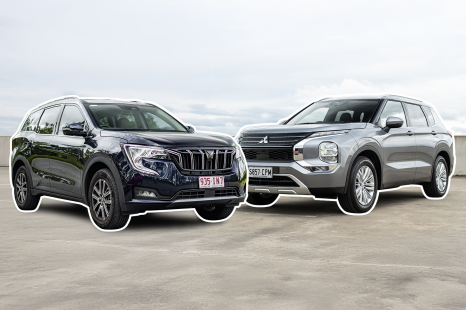

Andrew Maclean
4 Days Ago
Plug-in hybrid power is now available in the Evoque, but is it worth spending $20k extra to have the option of EV driving range?

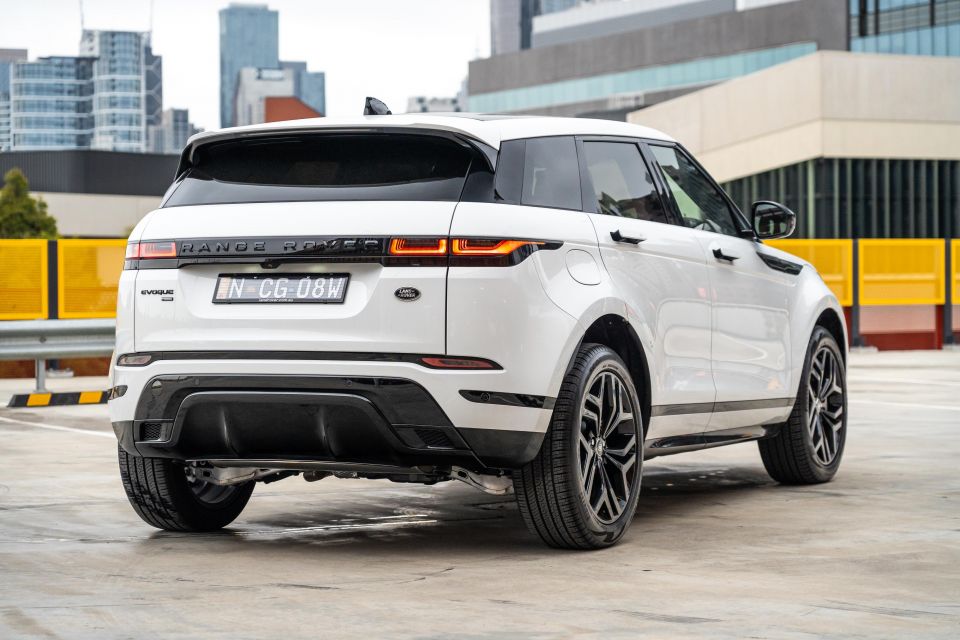

Quickly see how this car stacks up against its competition. Select any benchmark to see more details.
Take advantage of Australia's BIGGEST new car website to find a great deal on a Range Rover Evoque.
The Range Rover Evoque is one of those cars that most people just know.

While it may not have the legacy of its larger sibling – the Range Rover – the Baby Rangie has made a name for itself beyond the automotive industry as something of a fashion statement or accessory.
Blending the Range Rover’s iconic lines and design trademarks with a city-friendly size, the Evoque has become a very desirable small SUV since it launched in its first generation back in 2011.
Fast forward to 2023, and the second instalment of the Evoque story is approaching the mid-point of its lifecycle, having launched globally in 2018.

The second-generation Evoque launched with mild-hybrid drivetrains, and now there’s a plug-in hybrid available with up to 60 kilometres of pure-electric range. That’s the car you see here.
A baby Range Rover with EV capability? Seems logical… Does the $104,000 price tag stack up, though?
As noted above, the 2023 Range Rover Evoque PHEV – or P300e R-Dynamic HSE – starts from $104,310 plus on-road costs, which is a couple of grand more than when it first went on sale in 2022.

It makes the plug-in $20,000 dearer than the equivalent-spec P250 version, which runs a 2.0-litre turbo petrol engine.
It also sits the Evoque PHEV against bigger cars, and high-end versions of them. The upcoming Audi Q5 55 TFSI e quattro S line is available to order from $102,900 with similar range and more performance, while the BMW X3 xDrive30e M Sport is priced from $110,400 before on-roads.
You can even get the electric BMW iX3 from $104,900 if you’re tossing up whether to go premium PHEV or all-out EV. The popular and more powerful Volvo XC60 Recharge PHEV is also more affordable at $101,990.
It’s safe to say perceived value isn’t necessarily the Evoque’s strong point, although some will no doubt be willing to pay plenty for the Range Rover badge.

2023 Range Rover Evoque pricing:
Prices exclude on-road costs
The baby Range Rover look and feel continues into the cabin.

The Evoque’s cabin presents as very modern and high end, even five years after its release. You can imagine how new-age it must have felt back in 2018.
Our test car was finished with the Kvadrat textile and Dinamica suede interior ($527 incl. Premium Textile Pack), which features a cool wool blend with Union Jack perforation pattern. I know a lot of people like leather, but the cool factor and comfort of this upholstery is top-notch.
Ahead of the driver is a lovely multifunction steering wheel, which has been taken straight out of larger Range Rover products and features gloss black buttons that look touch-capacitive but are more mechanical in operation. They’re a magnet for fingerprints, so keep a cloth handy or make sure your hands are clean.
Oddly, even the top-spec Evoque doesn’t come standard with a fully digital instrument cluster. Rather, you get a 7.0-inch display nestled between two half analogue dials. The base cluster essentially offers the same menus and functionality as the fully digital one, and even parts of the dials are digitised – why not just do the entire thing then?
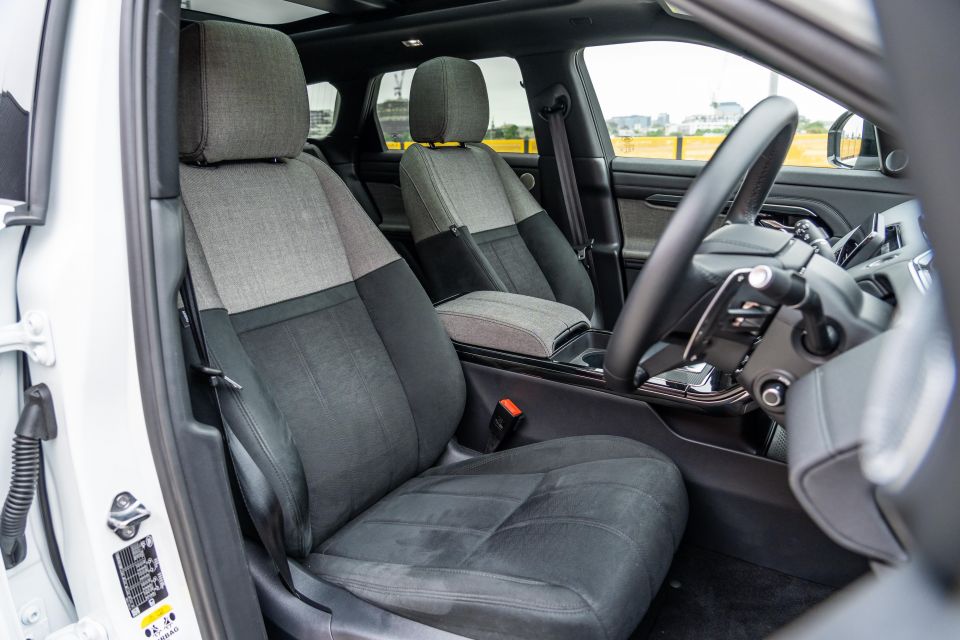

Range Rover will charge you $845 for the fully digital unit, which is rude on a $104,000 vehicle. Even worse is the $1690 you’ll need to splurge for a head-up display – really?!
At least the front seats are supremely comfortable, and offer a wide range of electric adjustment. As standard on the R-Dynamic HSE specification you get 14-way electric adjustment up front with driver memory; though steering wheel adjustment is manual – electric steering column adjustment is optional.
Even with some of the more basic equipment items as tested, there’s a real air of luxury in the cabin. There’s as much soft-touch surfacing as I’ve seen anywhere in the segment, there’s a level of insulation that makes you feel like you’re in a recording studio at times, and everything you touch feels high-end.
It could be made even nicer with more leatherette surfacing with contrast stitching on the dashboard and door tops, for example, but the Evoque’s cabin presentation is still up there with the best in class well into its life.


Another feature nipped from the larger Range Rover models (albeit older ones) is the 10-inch touchscreen with power adjustable angles. It’s running the brand’s latest software like you’ll see elsewhere in the Land Rover and Range Rover portfolio, so don’t think it’s stuck in the past.
It has native satellite navigation, wireless Apple CarPlay and Android Auto, and hybrid-specific menus and functions in this variant. It also comes standard with a year’s worth of connected functions including a data plan – though DAB radio is a silly $520 option.
If you’re like me and just stick to smartphone mirroring, the wireless Apple CarPlay connection was faultless during my time with the Evoque, and like the native interface everything works swiftly and smoothly.
Lower down is a touchscreen interface for vehicle functions like climate control, drive modes, and off-road settings. It’s quite swish, and again is nicked from the brand’s larger models. It’s simple to navigate – more in line with Audi’s latest MMI touch system rather than some other, more fiddly units.


The Evoque, despite being classified as a ‘Medium SUV’ by VFACTS segmentation, is more in line with the Small SUV rivals like the BMW X1.
At 6’1 I can sit behind my preferred driving position, but it’s snug rather than spacious. Put anyone taller than I in the driver’s or front passenger’s seat and an above-average adult won’t be happy in the second row for long stints.
Our test car’s optional panoramic sunroof ($2990) didn’t impede headroom too much thanks to the Evoque’s somewhat boxy shape, even if the roofline appears to be quite tapered from the outside.
Separate temperature controls in the rear are another odd option, and at $1300 they’re quite expensive. However, standalone rear vents are standard, thankfully.
Map pockets, USB-C charging ports and a fold-down centre armrest with cupholders are handy amenities to have, as are the ISOFIX anchors on the outboard seats as well as top-tether points for all three rear positions.


The Evoque’s boot area, like the second row, is more aligned with small-segment alternatives rather than its VFACTS-assigned medium-class rivals.
With 472L in five-seat configuration and 1156L with the rear seat backs folded (not very flat, mind you), the Evoque is much closer in luggage capacity to a Mazda CX-5 than a BMW X3. It’s definitely one of the smaller boots in this class.
It’s a nice and square area, all things considered, and there’s a little nook with netting to the side for smaller items.
Unlike some PHEVs that only supply a tyre repair kit, the Evoque features a space-saver spare wheel under the boot floor.
The Evoque P300e combines a 1.5-litre three-cylinder petrol engine with a lithium-ion battery and a rear-mounted electric motor.

New to the Australian market, the turbocharged three-pot is based on the unit offered on entry-level models overseas, tuned to deliver 147kW. The electric motor develops 80kW/260Nm on its own and exclusively powers the rear axle.
Meanwhile, the 15kWh lithium battery is large-ish for the class, and is mounted under the rear seats. Drive is channelled through an eight-speed automatic (not a nine-speed like other models), with all-wheel drive standard.
Range Rover says: “As well as being 5kg lighter than the nine-speed transmission used in the other models, the new eight-speed delivers enhanced refinement and shift feel and is an integral part of the hybrid system”.
The Evoque P300e develops a healthy 227kW and 540Nm, good enough for a 0-100km/h time of 6.4 seconds – making it the quickest variant. Combined fuel consumption is rated at 2.0L per 100km on the combined WLTP cycle, with combined CO2 emissions rated at 43g/km.

Range Rover quotes an EV range of up to 62km, and the Evoque PHEV is capable of driving in EV mode at speeds up to 135km/h.
Above this speed threshold, the e-motor is decoupled to reduce drag and increase efficiency – not that you’ll be reaching this velocity on public Australian roads.
Unlike most PHEVs, the Evoque P300e supports DC fast charging, at speeds of up to 32kW. At this charge rate, the Evoque can replenish 0-80 per cent in 30 minutes.
Using a 7kW AC wallbox, the battery can be recharged from 0-100 per cent in 2 hours 12 minutes.
It may be relatively small in stature, but the Evoque has a big-car feel on the road.

The PHEV in particular feels quite substantial from the moment you start rolling (in silence, no less), partly due to its inflated kerb weight compared to the equivalent P250 mild-hybrid – 2089kg versus 1794kg.
I got a similar feeling from the Volvo C40 Recharge I drove recently, which with its tall and fairly boxy proportions and hefty weight of its electrified underpinnings felt more solid than its segmentation might suggest.
Being a Range Rover, comfort and refinement are a priority, and the Evoque largely delivers, particularly in this P300e specification.
If you regularly charge the PHEV – which is what you should be doing if you’re buying one – most of your daily commuting will be done on electric power. This really ups refinement in town, particularly in stop-start traffic.
Power delivery is smooth and linear, but the 80kW e-motor at the rear isn’t going to feel particularly quick if you need more muscle. Even with 260Nm on its own, it’s going to feel more perky than punchy when shifting a 2.0-tonne SUV.

When you’re in traffic or around the ‘burbs like I was, it’s enough go for the most part. Some steeper hills like the undulating roads near my home in Doncaster will test it, but you can get away without firing up the petrol engine.
As you’d expect it’s a quiet thing to get along in, with minimal powertrain noise, and very little wind and road noise entering the cabin regardless of speed.
What wasn’t so great, and more odd than anything else, is that on a couple of occasions the Evoque overrode my selection of its EV Mode and fired up the 1.5-litre engine. One of these instances was my trip home after first picking it up, which really threw out the fuel consumption early on in heavy traffic as the engine was just running when moving, and idling when stopped.
The vehicle didn’t offer any explanation as to why it did this, and even selecting EV Mode on the lower touchscreen didn’t bring up any notifications.
Ride comfort on the standard 20-inch wheels and 235/50 Pirelli Scorpion Zero tyres is mostly fine with its passive suspension, though at times it can be a little jittery over the small imperfections that are common on inner city roads.

With its extra weight it can slap over some larger hits as well, but although it’s not as floaty as a car on air suspension, the cabin is still insulated from the hit. You can feel the wheels picking up imperfections without transmitting the full effect through your backside.
The Evoque handles like a bigger SUV than it looks as well. With light controls and a substantial-feeling footprint, the Evoque turns in with confidence though wouldn’t be considered sporty or sharp. Instead, it’s a confident, compact land yacht.
Its upright body and tall ride are reflected in the lofty driving position for what’s a relatively compact vehicle, feeding into that big-car feel.
You can shuffle through several drive modes as well to tailor the controls and powertrain beyond the Hybrid and EV settings, including Sport and Eco, as well as an array of Terrain Response settings for various off-road conditions – not that most Evoque owners will ever be heading far off the beaten track.
When in Sport the PHEV system primes everything for full attack, allowing it to offer its full 227kW and 540Nm. Accelerating onto a freeway onramp or overtaking on a country highway in this setting makes the Evoque feel muscular, even if it’s so linear it won’t necessarily blow your socks off.

Even when you’re not going full-tilt in a straight line, the hybrid system is particularly well-sorted once the petrol engine comes online, with excellent linearity and refinement. If you want to take further control there’s Satin Chrome paddle shifters behind the steering wheel, or you can use the trigger-style gearshift lever.
The three-cylinder thrum is quite charming and sounds far more appealing to my ears than the thrashy note of some four-cylinder motors, and the eight-speed auto does a great job of rifling through ratios imperceptibly just about all the time.
At times the lack of the ninth gear is felt on the highway. The engine spins at about 2000rpm at 100km/h, which can’t be optimal for efficiency. At least making it a longer ratio would help when you’re running out of battery, though it will shuffle in and out of EV Mode should there be enough charge.
The Evoque is pretty well equipped with assistance technology for the most part, with blind-spot monitoring and rear cross-traffic alert helping compensate for the rising belt line and smaller rear windows, while adaptive cruise control with stop/go functionality bearing the brunt of freeway driving and low-speed traffic jams.
The Evoque doesn’t however, have a proper semi-autonomous assistant with lane centring like you’ll find in most rival models.


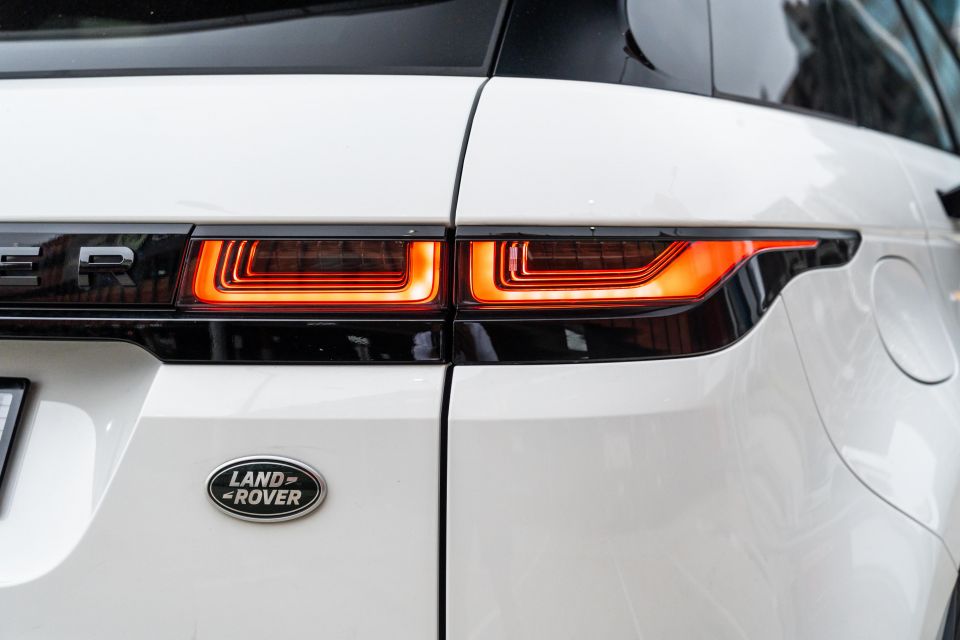

Evoque R-Dynamic SE highlights:
Exterior
Interior
Safety and Security
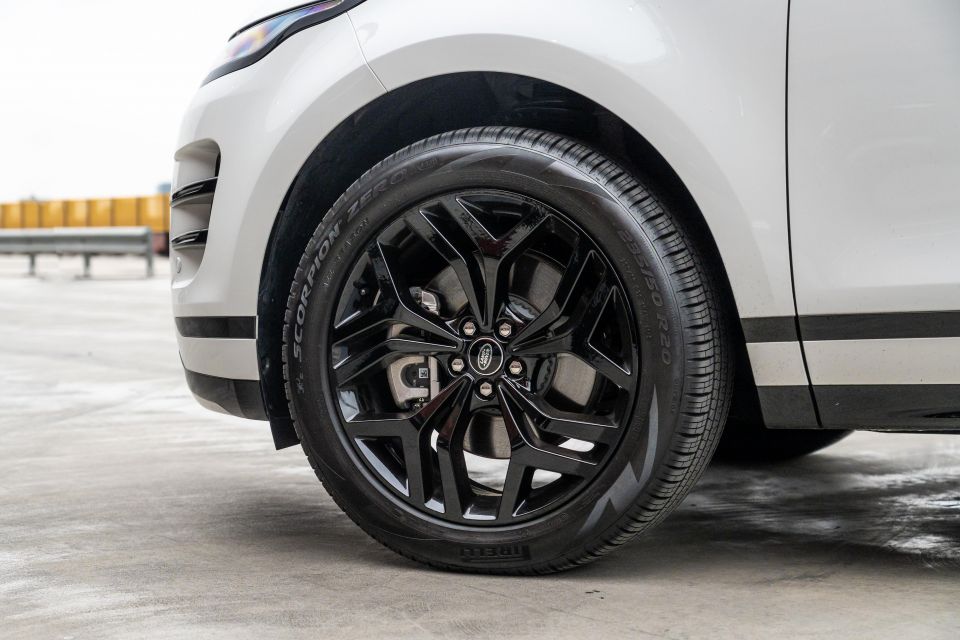

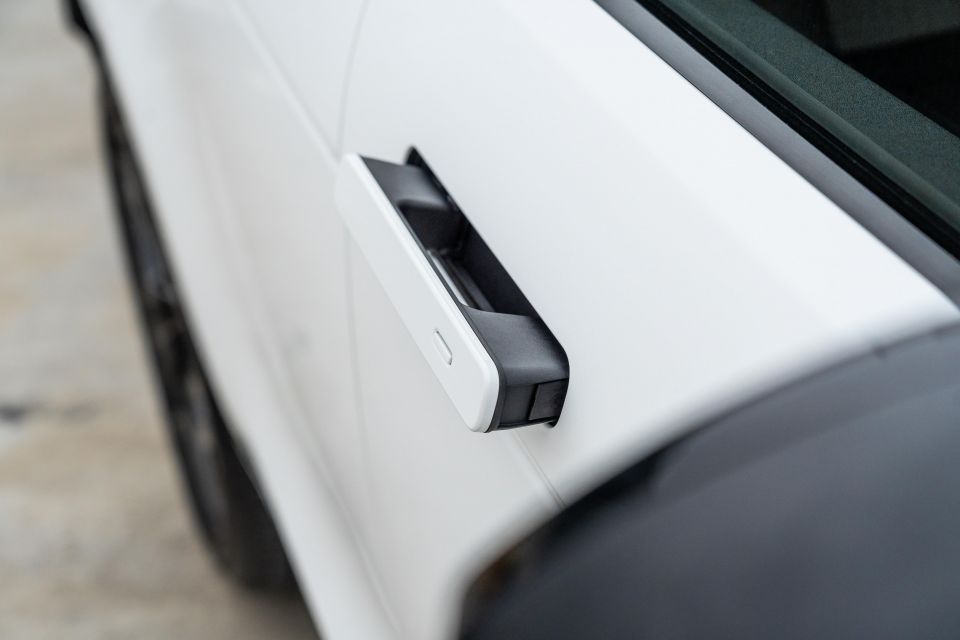

Evoque R-Dynamic HSE adds:
Exterior
Interior




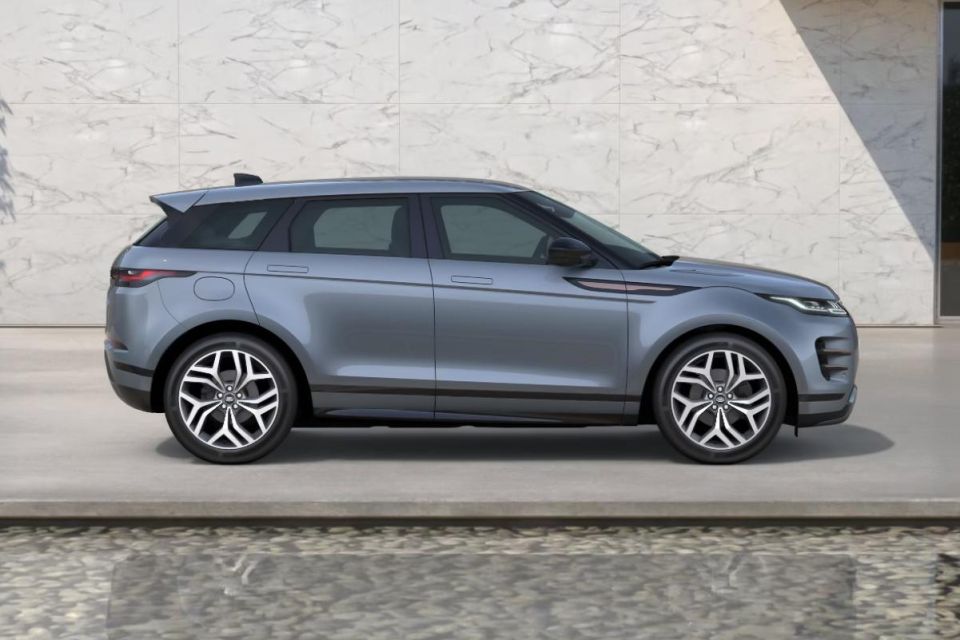






Solid ($NCO)
Metallic ($NCO)
Premium Metallic ($702)
The Evoque range wears a five-star ANCAP safety rating based on Euro NCAP tests in 2019.
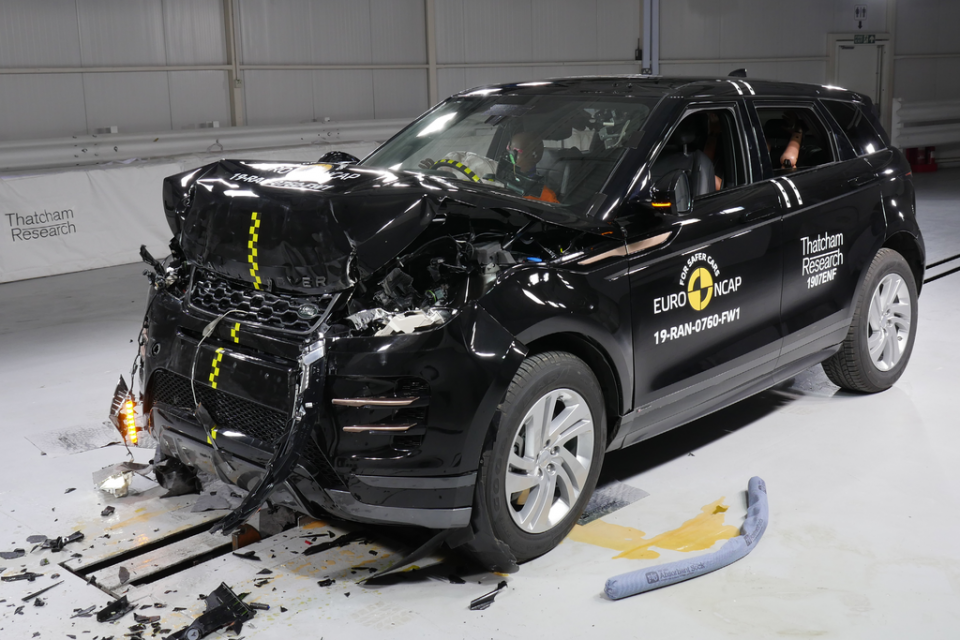
While the ANCAP rating covers “all variants”, it only explicitly mentions petrol and diesel models, not hybrids that were later added to the range – however, the Euro NCAP rating added the PHEV from 2021.
The Evoque scored 94 per cent for adult occupant protection, 89 per cent for child occupant protection, 72 per cent for vulnerable road user protection, as well as 73 per cent for safety assist.
Standard safety features include:
Evoque R-Dynamic HSE adds:
Optional features include:
*Currently unavailable due to component shortages
The Evoque is covered by Land Rover’s five-year, unlimited-kilometre warranty with five years of roadside assist.

Further to the new vehicle warranty, there’s a five-year Paint Surface Warranty for paintwork defects, a six-year Corrosion Protection Warranty for the bodywork, as well as a three-year warranty for 12V batteries, and eight-year/160,000km cover for PHEV/EV batteries (minimum 70 per cent health).
You don’t have to spend too much on servicing. Land Rover offers five-year/102,000km service plans across the range, and for the Evoque (incl. P300e PHEV) this retails for $1950, or $390 per annum. Quick division will show you that service intervals are 12 months or 20,400km – whichever comes first.
I finished my week with an indicated 4.6L/100km over 473km. This included a week’s worth of peak-hour commuting to and from the office, as well as daily errands and some more extended stints. I didn’t charge the Evoque every night, so include a day or so in there where the car was operating as a conventional hybrid with no usable EV range.
The Evoque would often show around 55 kilometres of EV range with a full battery, and I’d usually be able to get to work and back home without firing up the petrol engine if left in EV Mode. My daily commute is between 22km and 26km each way depending on the route I take, so 50km of real-world range is easily achievable.
I also used a free 50kW public charger in Coburg to test the DC charging rate, and replenished 11.38kWh in 37 mins. Again, not bad.
My first Range Rover was a good experience, but even as PHEV-believer I’m not sure I’d be picking the Evoque P300e.

Considering it’s virtually identical in spec to the P250 R-Dynamic HSE, the $20,000 price hike means the drivetrain needs to be bloody perfect for over $100k, and I just don’t think it’s good enough.
Yes it offers pretty good real-world EV range, but as we experienced the drivetrain would on occasion override the EV mode to fire up the petrol engine without warning, and the added weight of the hybrid components numb the dynamics and make the Evoque feel a little clumsier over city bumps – especially on the big standard wheels.
I will praise the excellent on-road refinement, both in terms of drivetrain smoothness and driveability, as well as cabin insulation. Unlike some entry-level luxury products, the Evoque feels like a genuinely premium product. Plus, the five-year warranty and affordable service packages should give added peace of mind if you’re wary of British reliability and running costs.
And, does anyone buys a Range Rover for the ‘value’ anyway? There’s added weight to the storied British badge that to many will put the Evoque a cut above Audi, BMW and Mercedes-Benz equivalents, correctly or otherwise.
The lack of features like a standard digital instrument cluster and proper semi-autonomous driving assists reminds you of the Evoque’s age, however, so a mid-life refresh (which shouldn’t be far off) is an opportunity to bring the Evoque in line with Range Rover’s latest and greatest.

Click the images for the full gallery
Take advantage of Australia's BIGGEST new car website to find a great deal on a Range Rover Evoque.
James is an automotive journalist based in Melbourne, Australia. Before joining CarExpert.com.au in 2020, James has worked at leading auto media outlets including Carsales and CarAdvice, as well as at Pulse agency for Ford Australia's communications team. In 2019 James made Mumbrella's 'Top 20 most prolific web authors in Australia' list after publishing 1,360 articles between March 1, 2018 and February 28, 2019 for CarAdvice. James is also an Ambassador for Drive Against Depression – an Australian charity whose mission is to support mental wellness through the freedom of driving and a shared love of cars.


Andrew Maclean
4 Days Ago


Max Davies
3 Days Ago
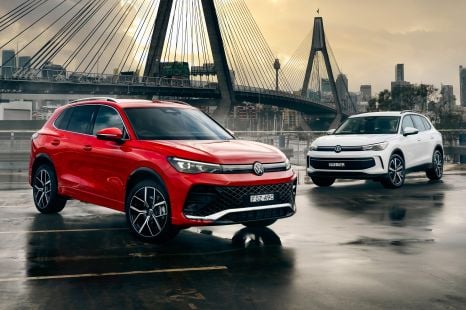

Max Davies
3 Days Ago


Josh Nevett
3 Days Ago
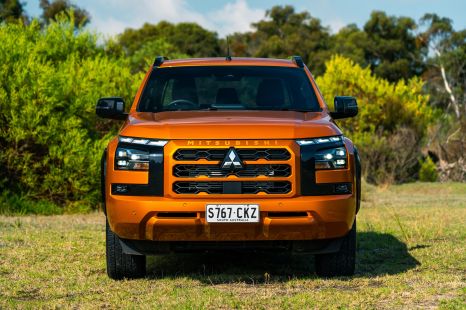

William Stopford
2 Days Ago
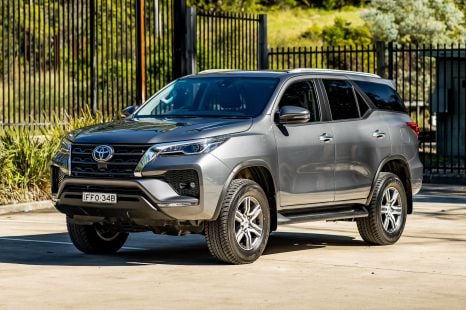

Matt Campbell
2 Days Ago